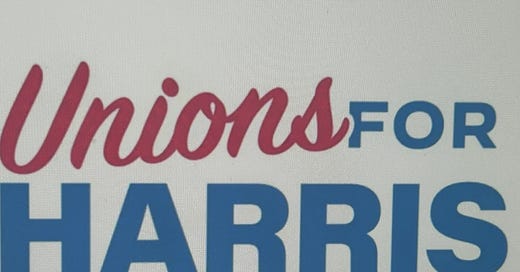How the Democrats Lost the Working Class and the Election
While there are clearly many factors that contributed to Harris’s and the national Democrats’ defeat, one thing stands out: it’s working-class economics, stupid.
It’s not a good sign when an election leads to a dramatic spike in sales for dystopian novels. But that was the case last week as what many believed would be a days’ if not weeks’-long wait for results in a very close race turned into an electoral college wipe-out win for Trump that left the Harris campaign, the Democratic Party, and many national pundits groping for answers.
While there are clearly many factors that contributed to Harris’s and the national Democrats’ defeat, one thing stands out: it’s working-class economics, stupid.
The day before the election, I outlined 10 key questions the results of the races would answer, the first of which was: “Has the National Democratic Party completely lost the white working-class in the industrial Midwest? The Democrats’ pitch on working-class issues was, win or lose, mixed at best. Where does what used to be the “party of the people” go if it has allowed the right to stake a claim on populism for the foreseeable future? Is there a winning formula that can write off this group of workers?”
As one union leader put it in a New York Times report on the election, “When you’re too conflicted between the interest of corporate America and average working-day people, I think this is what you end up with . . . a message that doesn’t resonate.”
That same Times article notes that Harris was caught between advisors from Wall Street, Silicon Valley, and corporate board rooms and those from more liberal and activist realms, resulting in a vacillating vision that pleased neither workers nor their corporate overlords, but veered toward the latter as she “adopted marginal pro-business tweaks to the status quo.” Trump’s billionaire populism, on the other hand, offered “broad but vague promises to cut taxes and shake up the global trading system.”
It turns out that fake billionaire populism sprinkled with anger at a host of demonized “others” who were allegedly poised to gain at the expense of American workers was preferable to yet another round of Democratic neoliberalism with nods towards the need for incremental changes in the system.
In my column the week before the election in this space, I cited the catastrophic failures of the New Democrats who governed with a neoliberal economic policy and trade deals that helped gut the industrial Midwest, leaving many voters fundamentally alienated from the system itself and the Clintonite turn of the Democratic Party in particular. My fear was, despite that history, Harris and her team (who decided it was a great idea to go on tour with Liz Cheney down the stretch run) would end up looking back and realizing that they “absurdly surrendered economic populism to the billionaire class and lost.”
They did.
A new book by Lainey Newman and Theda Skocpal, Rust Belt Blues: Why Working-Class Voters are Turning Away from the Democratic Party, addresses the deep roots of this problem and observes that as plants started to close and jobs went away across the heartland beginning in the 1970s and 80s, unions declined and along with that loss of labor density came a hole in the social fabric of communities. Unions that used to be the center of working-class lives stopped playing that pivotal role, and, as we learn in the Harvard Gazette piece on their book, when “the union’s social role eroded, workers filled the void with other, often more conservative groups,” such as gun clubs and other rightward-leaning associations.
Thus, as the social fabric of many American communities declined, an epidemic of loneliness, desperation, addiction, and despair helped foster an environment where anger was fueled and then redirected not toward the economic elite, but, as Thomas Frank has argued, toward the “cultural elite,” the college-educated Democrats who frequently carried all the trappings of the professional managerial class. Making things worse was the fact that rather than trying to shed that image and relearn how to be the party of the people, Democrats frequently stepped right into the role of scolds telling workers that they just needed to go back to school and update their skills for the new world they had had thrust upon them.
It didn’t work.
And despite Biden’s historically brief period of trying to bring labor back into the fold of the party, many of his efforts helped unions institutionally, which made the leadership happy, but failed to quickly impact the lives of rank-and-file workers, union or not. Hence, Harris’s pivot toward leaning on corporate advisors on economic matters while still extolling the value of labor fell on deaf ears across the industrial Midwest.
Frank’s analysis in the New York Times is instructive, if not uplifting:
I fear that ’90s-style centrism will march on, by a sociological force of its own, until the parties have entirely switched their social positions and the world is given over to Trumpism.
Can anything reverse it? Only a resolute determination by the Democratic Party to rededicate itself to the majoritarian vision of old: a Great Society of broad, inclusive prosperity. This means universal health care and a higher minimum wage. It means robust financial regulation and antitrust enforcement. It means unions and a welfare state and higher taxes on billionaires, even the cool ones. It means, above all, liberalism as a social movement, as a coming-together of ordinary people — not a series of top-down reforms by well-meaning professionals.
Of course, many will learn the opposite lesson and claim that Biden/Harris’s labor allies failed to help her win even though the union vote for Harris was about the same as it was for Biden. This would be a fatal error and just might lose the white working class along with good numbers of workers of color in the “blue wall” states for the indefinite future.



